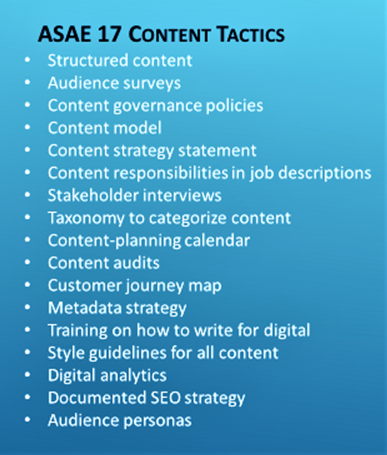Be the Voice Your Members Want to Hear—A Content Strategy Makes It Happen

Siloed organizations used to be hard to manage; today, they are a real business liability. Success in the digital marketplace depends on a holistic approach—this is a mantra that I can’t repeat frequently enough. Systems, teams, and departments must all be directed toward common goals.
If imposing this level of discipline seems daunting, a content strategy is an effective tool to get your cats running in the same direction. As technology advances, those felines become harder to herd. Content has outstripped the written word. For better or worse, electronic media makes everyone a producer. Video, audio, and written information are simple to create and propagate. Unfortunately, we aren’t all able to give an Oscar-worthy performance.
Content strategy is a gift that technology gives us to manage this unruly behavior. The term has been widely used in web development since the 1990s. The Content Strategy Alliance offers this succinct definition: “getting the right content to the right user at the right time through strategic planning of content creation, delivery, and governance.” The ASAE Research Foundation takes this tack: “the planning and judgment for the creation, publication, dissemination, and governance of useful, usable, effective content across departments and functional areas.”
Don’t Confuse Strategy With Tactics
There is a subtle distinction between content strategy and content marketing. A content strategy provides policies and procedures to ensure that communications, education, and messaging are firmly tied to the organization’s overarching business and cultural goals.
Content marketing is an outcome of that strategy. It includes roadmaps (think search engine optimization) and perks (such as downloadable freebies), along with a variety of other activities designed to promote relationship building. The goal is to generate leads, develop brand loyalty, and turn prospects into customers or members. Without a deliberate intention or strategy, tactics are empty calories. They are liable to deplete your energy and stunt your growth.

Most groups engage in some content marketing. In 2019, ASAE conducted a survey to assess how associations were using 17 common techniques. They ranked organizations that engaged in six or fewer as beginners, and those employing between 7 and 13 as intermediate. The experts demonstrated a holistic approach by using 14 or more tactics. There was limited membership in that elite group. I imagine that the events of 2020 pushed most organizations up a notch on the scale.
Not surprisingly, the tactics that were easiest to implement were the most popular. Editorial calendars, style guides, and analytics were frequently cited. While any activities that support effective content management may be beneficial at the departmental level, I would argue for taking a 360-degree, organization-wide approach. I hope more associations will begin using strategy to turn marketing exercises into solutions that address their greatest challenges.
Discipline Reaps Rewards
Exercising the discipline to treat content strategically is demanding. But there are considerable rewards for those who take the journey. A content strategy will:
- Align goals in the strategic plan with output across departments.
- Give members what they want, when they want it, in the format they prefer.
- Deliver value and demonstrate your organization’s relevance.
- Solidify your leadership role in the profession.
- Help drive dues and non-dues revenue.
- Demonstrate that your association is evolving to better meet the needs of target audiences.
- Allow staff to work smarter, not harder.
- Encourage collaboration and teamwork.
- Improve morale and corporate culture.
That’s a big payoff. Each of those bullets is reason enough to test your organization’s ability to become a commanding voice amid the online chatter.
The enthusiasm to launch and sustain an effective initiative begins at the top. CEOs must be the champions of connecting business strategy with marketing. They must advocate and enforce an organization-wide approach that rewards success and discourages missteps. As with any new venture, allocating appropriate financial and human resources is critical. Equally important is the courage to admit mistakes and recalibrate when plans are derailed.
Amy Williams, Senior Consultant, .orgSource, puts it like this: “Associations should consider their marketing teams as strategic partners. It’s one of the few departments with a full line of sight across the organization. If the marketing team doesn’t have influence and involvement in developing the strategic plan, there’s a major disconnect, which results in missed opportunities. It is the job of marketers to listen to the customer and influence the organization’s strategy.”
With the CEO on board, responsibility for implementation can be delegated to a team of six to eight individuals. This group should have a clear understanding of the organization’s strategic plan and represent key stakeholders. They will be ambassadors for the initiative.
Ideally, the team should include a champion who prioritizes activities, guides the project, and is the primary spokesperson; a manager who supervises the team, and interdepartmental representatives who coordinate workgroups across the organization and identify and remove obstacles to progress.
Mission Establishes Meaning
The core team will appoint ad hoc teams as needed and interface with content creators in various departments. One of their first jobs will be to create a content mission statement to establish these defining principles:
- Why is content being created?
- What type of content will be developed?
- Who is the consumer?
- How will they benefit?
- What is the desired outcome?
The mission statement, which is based on the organization’s strategic goals, has the dual role of being a litmus test to determine whether or not content is acceptable as well as an expression of the value the organization strives to provide to constituents. A number of different templates can be used to create this definition. Below is one example from the Content Marketing Institute:

A completed statement might read like this:
The content the Widget Association produces supports our goal of being the premier provider of education to the widget community, including: members, vendors, customers, and other advocates of widgetry and the recognized authority of widgetdom so that our constituents feel valued and recognized by the public in order to achieve their professional goals.
You’ll know you have a solid statement if it meets these criteria:
- Aligns to your strategic plan
- Identifies the same audiences
- Supports key initiatives
- Advances the mission
The core team will go on to do the detailed work of putting tactics in service to strategy by:
- Assessing current content
- Creating a content inventory
- Identifying target audiences
- Curating content to meet their needs
- Optimizing for search engines
- Identifying delivery channels
Content Defines Value
Without content, associations are social clubs. While networking is important, it is not a substitute for expertise. Your content defines your value and determines your relationship with your audience/s. The digital marketplace is a raucous bazaar where the hawkers are all trying to outshout each other. In that crowded competition, a content strategy will make you the voice of authority that your members’ are eager to hear.
If your organization could benefit from a content strategy, .orgSource is ready to help.

